In friendships and romantic relationships, anxious attachment shows up as someone worrying a lot about being left, needing frequent reassurance, and taking small changes, like a late text or quiet mood, as evidence that they are being left behind.
Attachment Theory
What Is Attachment Theory?
Attachment theory centers on relationships and bonds between humans, such as the one between a parent and child or in romantic relationships.
Attachment theory serves as a psychological explanation for how certain types of bonds influence a person’s life.
John Bowlby was a psychologist who studied young children and adolescents and their behaviors and relationships.
He developed a new approach to understanding and explaining certain childhood behaviors, known as the attachment theory.
What Are the 4 Stages of Attachment Theory?
There are four stages of attachment theory, which include:
- Pre-attachment stage
- Making the attachment (Indiscriminate)
- Clear-cut attachment (Discriminate)
- Multiple attachments (Reciprocal)
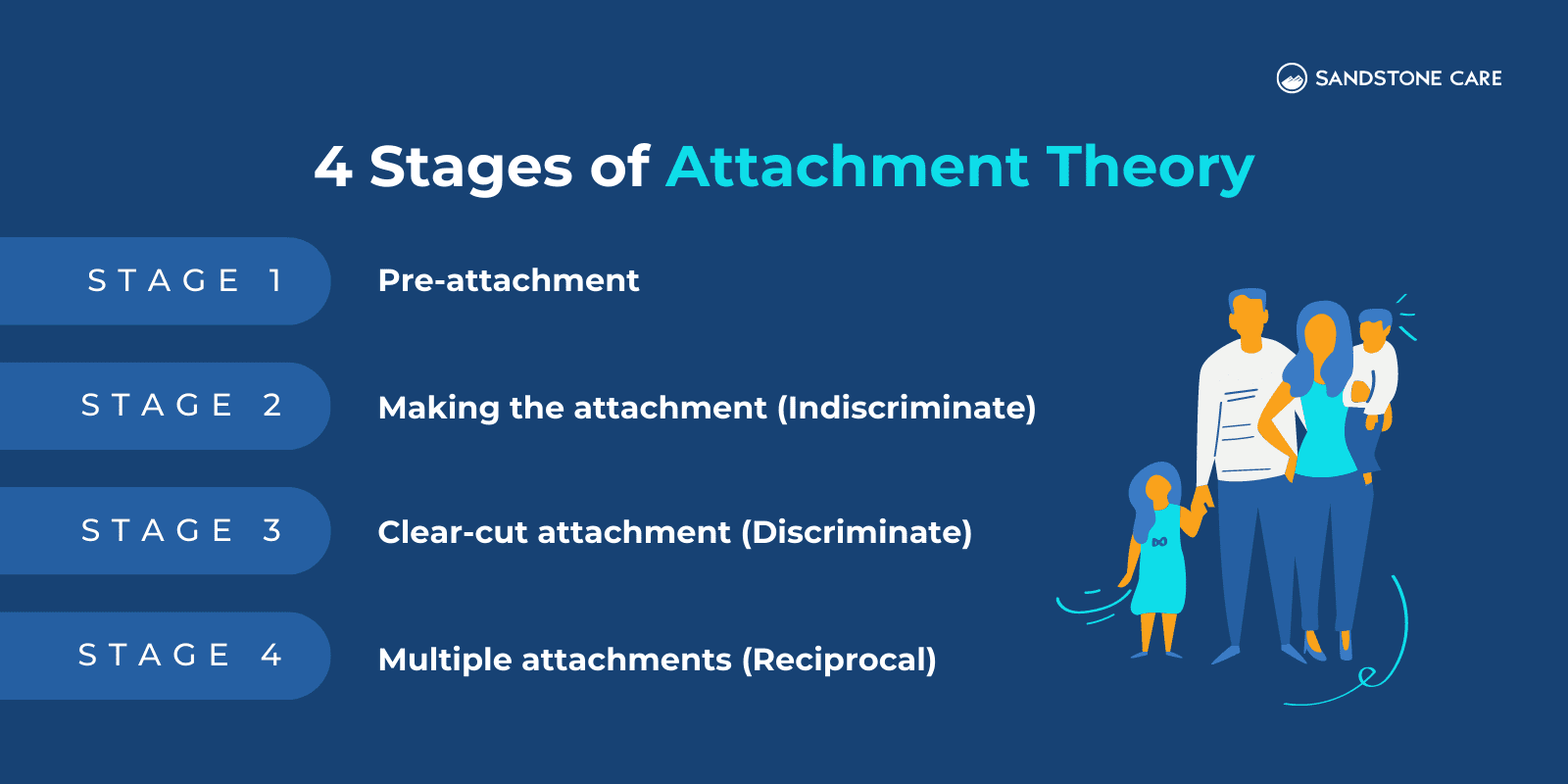
What Is an Example of Attachment Theory?
One example of attachment theory is the secure attachment style.
This may be seen in the bond between a mother and her child. Different attachment styles often manifest in caregiver relationships.
When a child has a secure attachment to their parent, they can feel confident in going to their parent for comfort. Their parent meets their needs and is attentive, caring, and responsive to the child. Attachment security is a key aspect of emotional development.
In a secure attachment, the child feels comfortable exploring because they know their parent is there to support them.
What Are the Pros and Cons of Attachment Theory?
Attachment theory can help explain and understand the behaviors of young children and adults.
However, there can be some advantages and disadvantages to the attachment theory.
For one, attachment mainly focuses on the bond between a mother and their child or on a primary caregiver and a child. It sometimes doesn’t consider other significant relationships and factors in a person’s childhood.
Additionally, when someone takes an attachment style into account, the events a person goes through between childhood and adulthood are frequently overlooked. It is often assumed that if a person has a certain attachment as a child, that is how they will be as an adult.
Attachment theory sometimes doesn’t acknowledge the change, growth, and self-work a person does to build healthier relationships.
For example, a child who developed an anxious attachment style when they were young may realize it when they become older and actively work on building healthier bonds and relationships beyond the experiences they faced as a child.
The positive of attachment theory, however, is that it gives insight into why people behave the way they do in relationships and gives them a type of guidance to change these patterns.
Attachment theory can provide clarity and support in knowing that there is nothing wrong with them, that their feelings are valid, and that there is a reason why they feel the way they do.
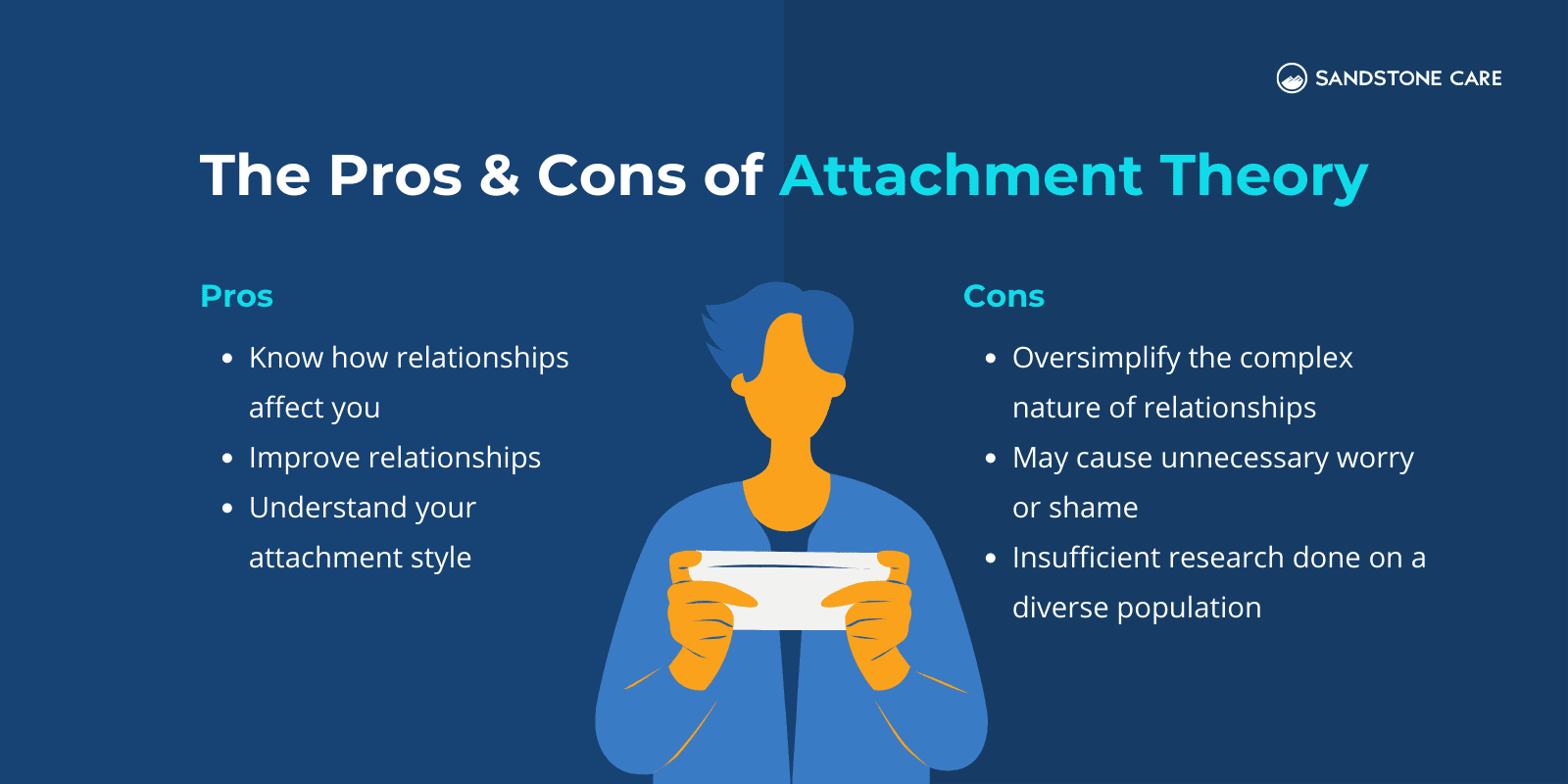
How Does Attachment Theory Explain Trauma?
When a person goes through traumatic experiences, whether in childhood or adulthood, it can impact every aspect of their lives, including their relationships.
Trauma can often lead to insecure attachments like disoriented/disorganized attachment, where the child or individual has difficulty trusting other people, has a fear of rejection, and a fear of becoming close to someone.
However, they may also seek closeness out of fear of losing the other person or being rejected.
When a person experiences trauma, it can affect the way they see the world and the way they see other people. Over time, they become closed off to other people in order to protect themselves.
Attachment Styles
What Are Attachment Styles, and How Are They Formed?
There are four main attachment styles which include:
- Secure attachment style
- Avoidant attachment style
- Disorganized attachment style
- Anxious attachment style
Attachment styles are essentially formed through the relationship and bond between the parent or permanent primary caregiver and the child.
They can follow generational patterns because many people learn about connection through their primary caregiver, and pass the same learnings to their children, although this is not always the case.
Attachment styles are most often formed during the first year of life and are formed through the responses of the primary caregiver when the child is facing emotional stress.
Attachment styles can also appear in other conditions, such as reactive attachment disorder.
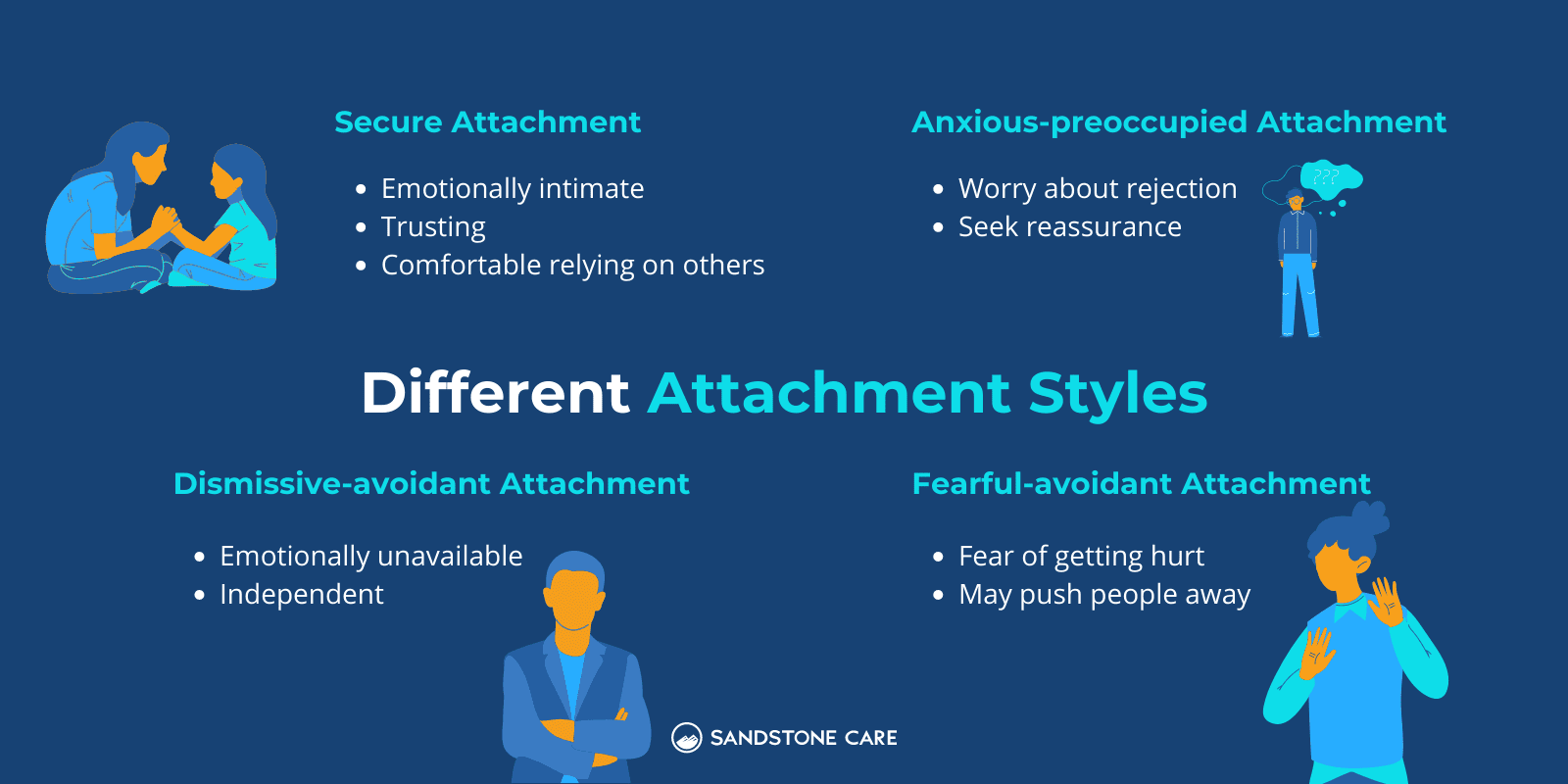
What Are the Three Factors that Influence Attachment Styles?
Many factors can influence attachment styles, including:
- Experiencing major stressful/traumatic events such as severe illness, abuse, or loss of a parent
- Family size and income
- The child having multiple care placements
What Is the Most Common Attachment Style?
Secure attachment style is the most common.
In a secure attachment style, the child feels safe with their caregiver, likes to be with them, and knows they can go to them if they are afraid or stressed.
They also generally feel confident in exploring new things because they know they can return to their caregiver if needed.
Sometimes, they may feel a little anxious if their caregiver leaves them, but they feel comforted and happy when they return.
What Is the Rarest Attachment Style?
The avoidant attachment style, also known as the fearful-avoidant attachment style, is the rarest form and develops when a child becomes fearful of their caregiver instead of feeling safe.
When a child has developed this attachment style, they may desire closeness but at the same time are scared of it.
They often feel anxious or uncertain about the people in their life and have difficulty trusting others.
What Is the Unhealthiest Attachment Style?
Anxious attachment styles, disorganized attachment styles, and avoidant attachment styles are considered insecure/unhealthy forms of attachment.
When a person has one of these attachment styles, it most often comes with feelings of anxiety, emotional pain, and distress. They may rely to heavily on people, or try to avoid getting help from others at all – such as with hyper-independence.
It can be very hard to develop healthy relationships in childhood and adulthood. However, attachment styles are not permanent and can change with time and effort.
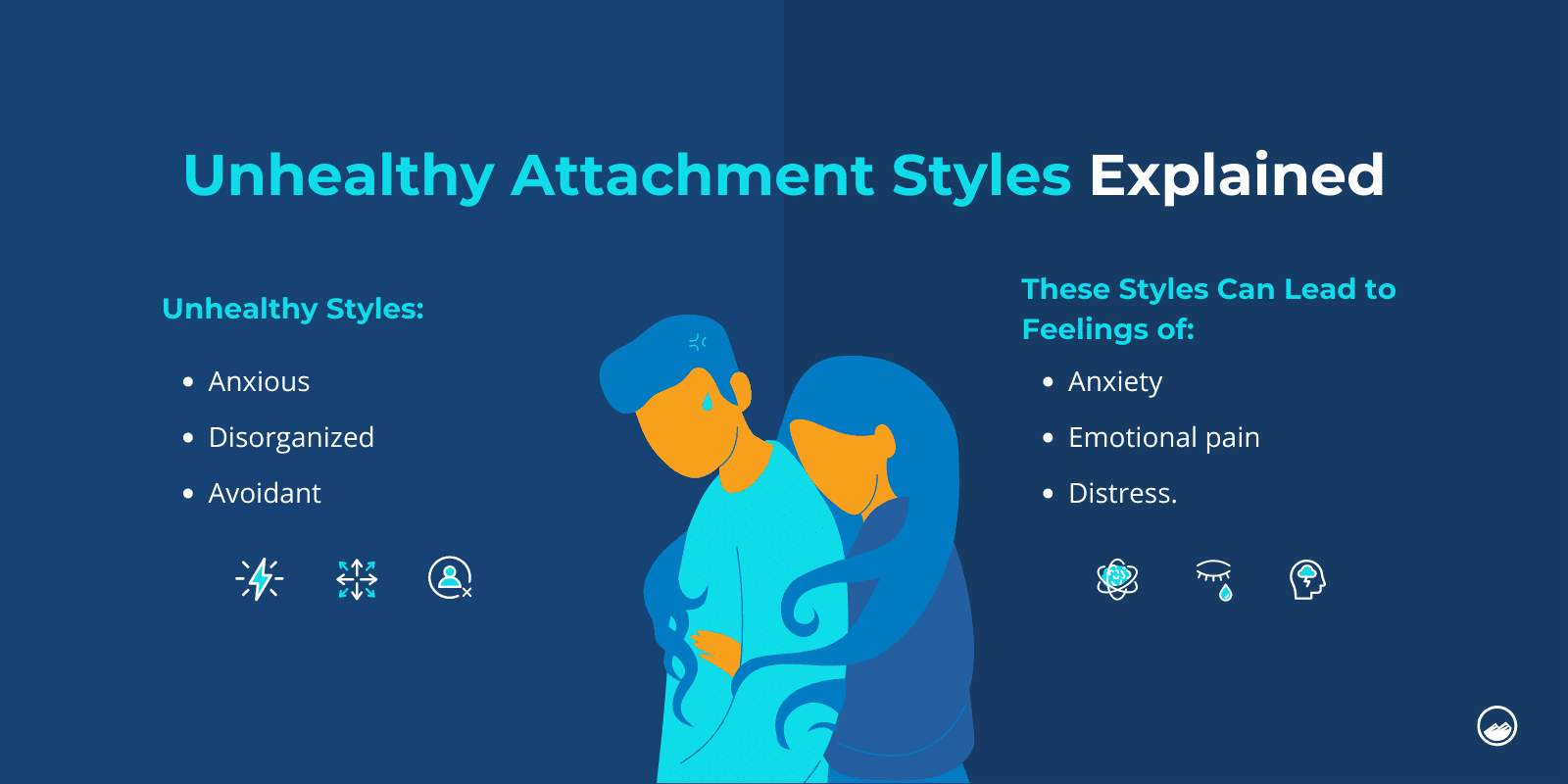
Can You Have All 4 Attachment Styles?
A person can have different types of attachment.
Every individual is unique and does not have to fall under one single category or one of the patterns of attachment.
This can happen in various scenarios, like having two different caregivers that have different styles of attachment.
Attachment Styles & Childhood
Are Attachment Styles Formed in Childhood?
Yes, attachment styles are believed to form in early childhood, mainly in the first year of life.
The bonds and relationships built with parents or primary caregivers at a young age can impact a person’s relationships into adulthood.
However, knowing that these attachment styles are not permanent and can change over time is important.
At What Age Are Attachments Fully Formed?
When a child turns two years old, they are likely to have already formed a strong attachment to their primary caregiver.
But, attachment styles can change as a person gets older and recognizes the patterns in their life if they try to change them.
How Does Your Childhood Affect Your Attachment Style?
Your childhood plays a significant role in your attachment style.
According to Bowlby, attachment focuses on the bond between the permanent primary caregiver and a child.
The early stages of a child’s life play a significant role in each child’s mental health and stability.
Different factors in childhood can experience a person’s attachment style, including:
- Family size
- Living situation
- Stressful or traumatic experiences
- Health and well-being of parents
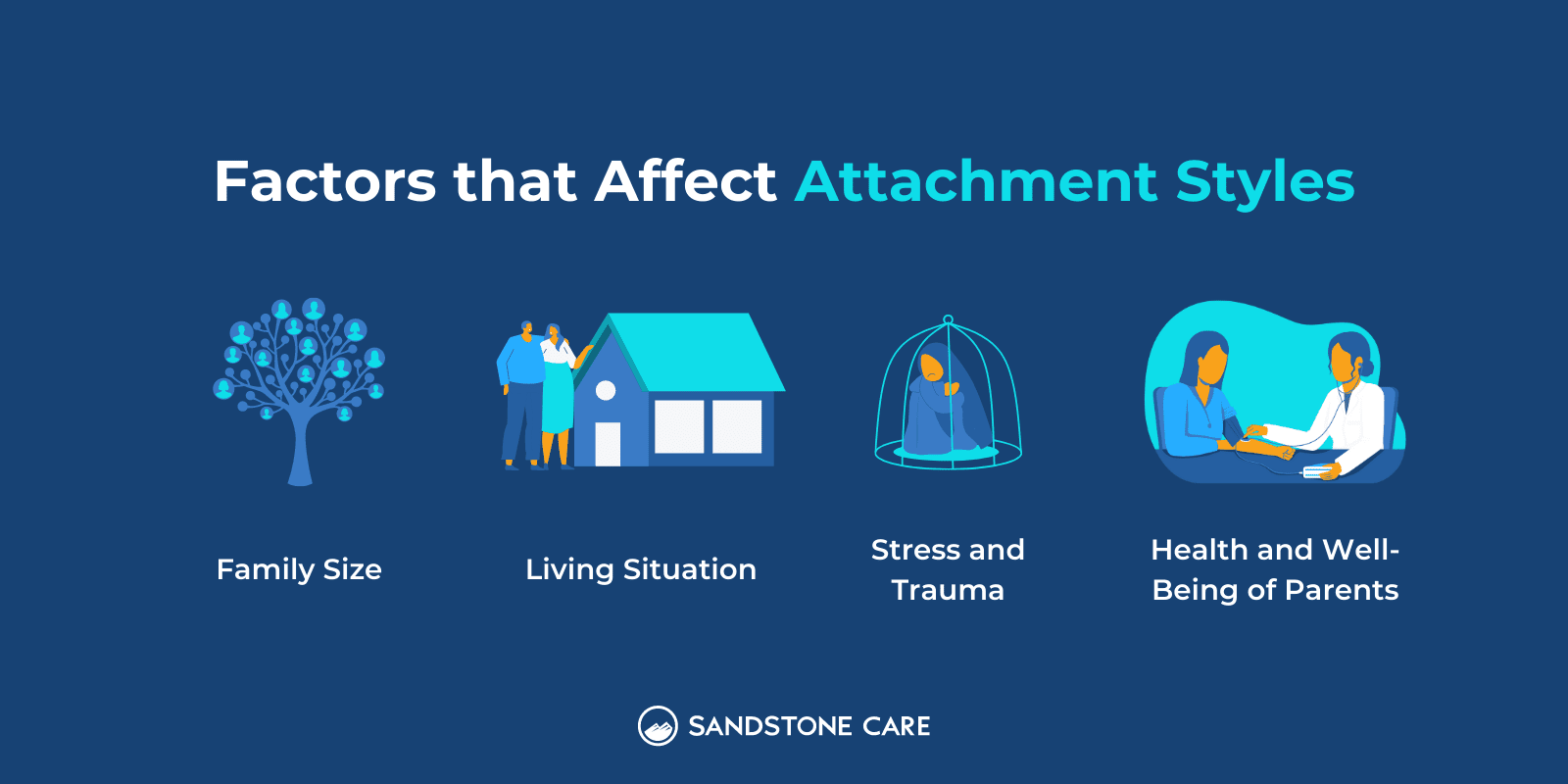
How Does Attachment Change from Childhood to Adulthood?
The attachments and bonds that you build in childhood can significantly impact your adult relationships and adult attachment styles, although they can also change over time.
Some people recognize the unhealthy patterns in their relationships and consciously try to change them. Others change slowly over time as they grow into an adult.
How Does Childhood Trauma Affect Attachment?
Experiencing childhood trauma can lead to insecure attachment styles, where the individual feels a lack of safety, accompanied by feelings of anxiousness, problems with trust, and difficulty forming connections with others.
Anxious Attachment Style
What Is an Anxious Attachment Style?
An anxious attachment style is when someone wants to feel very close to others but often worries about being left out or abandoned. This usually comes from growing up with caregivers who were loving sometimes but distant or unavailable at other times. Because of that inconsistency, the person learns to feel unsure if others will stay close or meet their needs.
In everyday life, this can show up in relationships and work responsibilities.
For example, a person with an anxious attachment style might text their partner many times if they don’t get a quick reply, because they fear something is wrong. They may also seem upset if a friend cancels plans, not just disappointed but worried that the friend doesn’t care about them anymore.
In romantic relationships, they might look for a lot of reassurance, asking questions like “Do you really love me?” even when things are going well.
What Are Signs of Anxious Attachment?
Signs of anxious attachment can include:
- Low self-esteem
- Fear of abandonment or rejection
- Need for closeness
- Afraid of emotions
- Overly independent
- Needing constant reassurance
People with an anxious attachment style often show clear patterns in how they behave and respond to relationships.
They may ask a partner or friend if they are still loved, wanted, or cared about, even when nothing is wrong. Another sign is a strong fear of being abandoned, which can make them clingy or very distressed if they sense distance.
They may also overthink or worry about small changes, such as a short text reply or a partner being quiet, interpreting these moments as rejection.
In some cases, they become overly focused on the relationship, making it the center of their thoughts and emotions. Mood swings tied to how connected or disconnected they feel with others are also common, and this can create tension in friendships and romantic relationships.
How Do Anxious Attachments Show Up in Friendships and Romantic Relationships?
Anxious attachment shows up in friendships and relationships as a mix of wanting closeness but constantly worrying that it might slip away. In friendships, this can look like someone getting really upset if a friend doesn’t text back quickly, or feeling hurt when plans are canceled, even if the reason has nothing to do with them.
They may put in a lot of effort to keep the friendship alive: checking in often, going out of their way to be there, because deep down they’re afraid of being forgotten or replaced. To the friend, it might seem like they care a lot, but it can also come across as needy or overwhelming.
In romantic relationships, those feelings often get even stronger. Someone with an anxious attachment style might ask their partner often, “Do you still love me?” or feel anxious if their partner is quiet or distracted. They may check in constantly, send lots of texts, or feel panic at the thought of being apart.
On the outside, it can look clingy, but on the inside it feels like trying to hold on tight to the relationship so it doesn’t disappear. Even small moments of distance can bring up big waves of fear that they aren’t good enough or that their partner might leave.
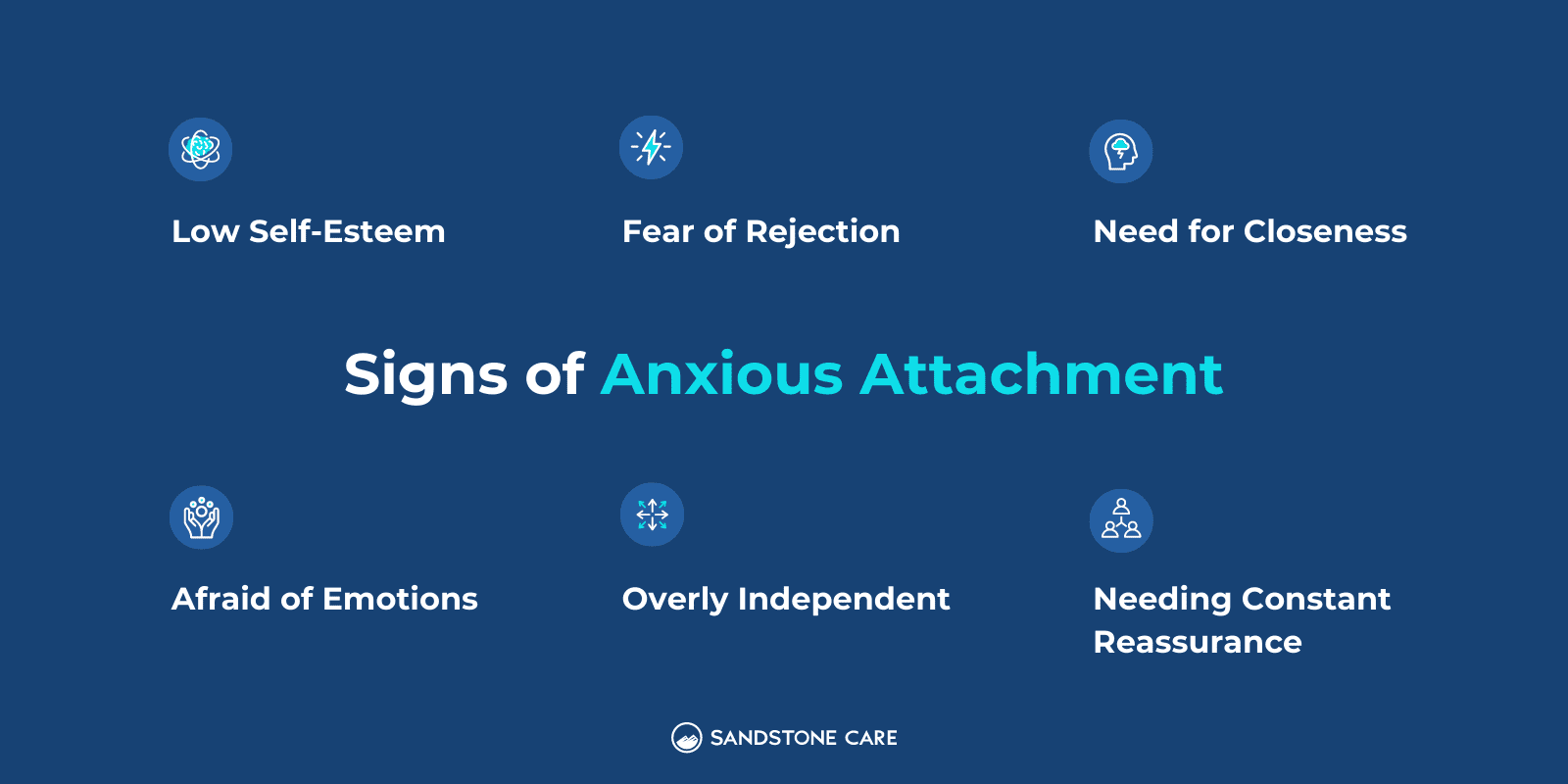
What Triggers Anxious Attachment Style?
Anxious attachment can be triggered by several different things, such as inconsistent parenting or being left behind in several important friendships and romantic relationships.
Another factor that could influence the development of an anxious attachment is when a caregiver seeks closeness with the child for their own emotional needs and not the ones of the child.
When this happens, the parent may appear over-protective (sometimes called a helicopter parent).
How Do You Break Anxious Attachment Style?
You can break an anxious attachment style by building self-awareness, healing past wounds, and practicing healthier relationship habits.
This starts with noticing the patterns, such as feeling panicked when a partner doesn’t reply right away or asking repeatedly for reassurance that a friend still cares.
With time, building your confidence, setting healthy boundaries, and choosing steady, supportive people can shift anxious attachment into something more secure. For example, instead of dropping everything the moment a friend texts, you might remind yourself it’s okay to finish what you’re doing first and trust that the friendship won’t fall apart.
Avoidant Attachment Style
What Does Avoidant Attachment Look Like?
Avoidant attachment is another form of insecure attachment, where a person seems emotionally disconnected and distant from close relationships.
For a person with an avoidant attachment style, intimacy can be very uncomfortable, and they may avoid getting too close to a person or giving them trust.
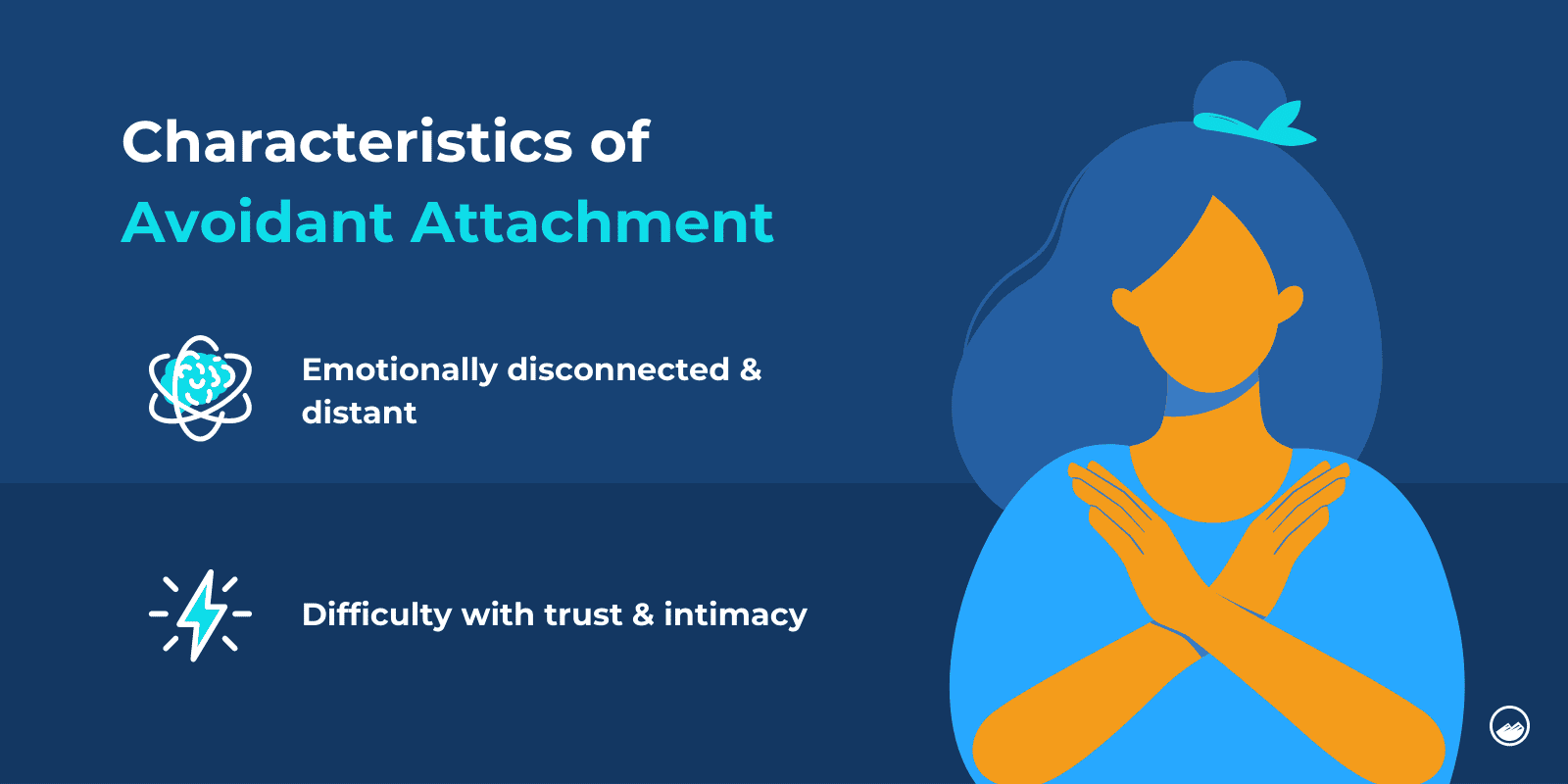
What Is an Example of Avoidant Attachment?
An adult with an avoidant attachment style may feel uncomfortable if their romantic partner is too clingy, and they may not like physical touch.
Sometimes, they will avoid getting into relationships altogether because they fear getting hurt or don’t want to become too close to someone.
In children, examples of avoidant attachment can be seen when they may be overly independent because they don’t feel like they have someone to go to.
A child with an avoidant attachment style may also seem to have little emotion. If their caregiver leaves them, they seem that they don’t care and may not cry or seem upset and move their focus to something else.
Can Avoidants Fall in Love?
Some people with avoidant attachment style may avoid getting into close relationships altogether.
Although it can be challenging for avoidants to build close connections in intimate relationships, they are capable of falling in love.
They can meet a person that understands them and what they need. It may just take some time and commitment to build a strong relationship.
What Causes Avoidant Attachment Style?
Avoidant attachment style often develops in individuals whose parents or caregivers didn’t allow them to express their feelings or who were emotionally distant themselves.
The individual may have been expected to be extremely independent at a young age and “tough” because they don’t go to their caregiver for comfort and essentially “deal with it.”
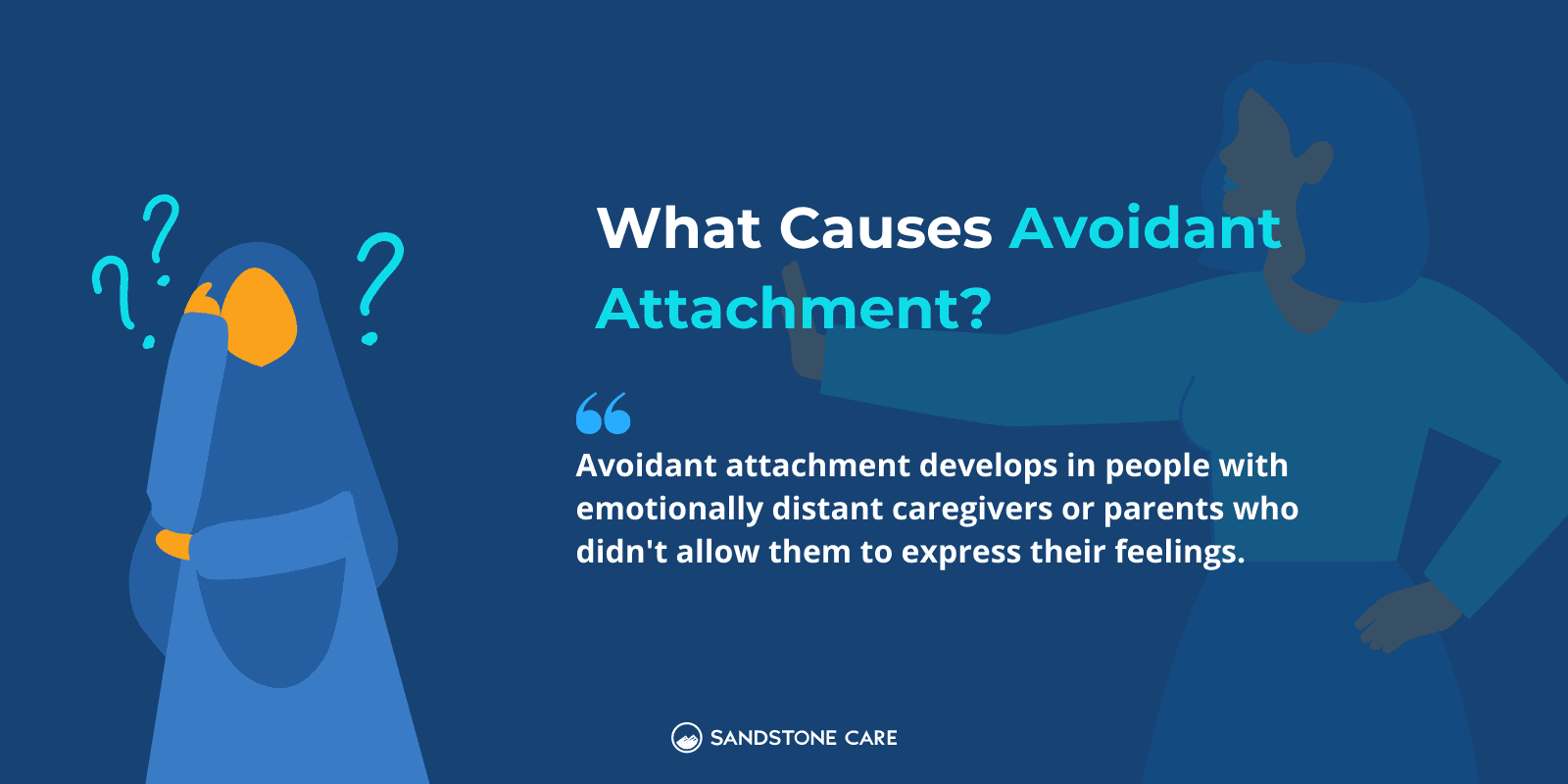
Disorganized Attachment Style
What Are Signs of Disorganized Attachment?
Some common signs of disorganized attachment in adults can include:
- Difficulty regulating emotions
- Needing to be extremely close or extremely distant
- Having difficulty trusting others
- Lack of emotional intimacy
- Fear of rejection or abandonment
- Low self-esteem
- Inconsistency in relationships
Disorganized attachment is often associated with mental health conditions such as anxiety and depression.
If you or a loved one are experiencing signs of disorganized attachment along with signs of anxiety or depression, it is best to reach out for help from your healthcare provider or a mental health professional.
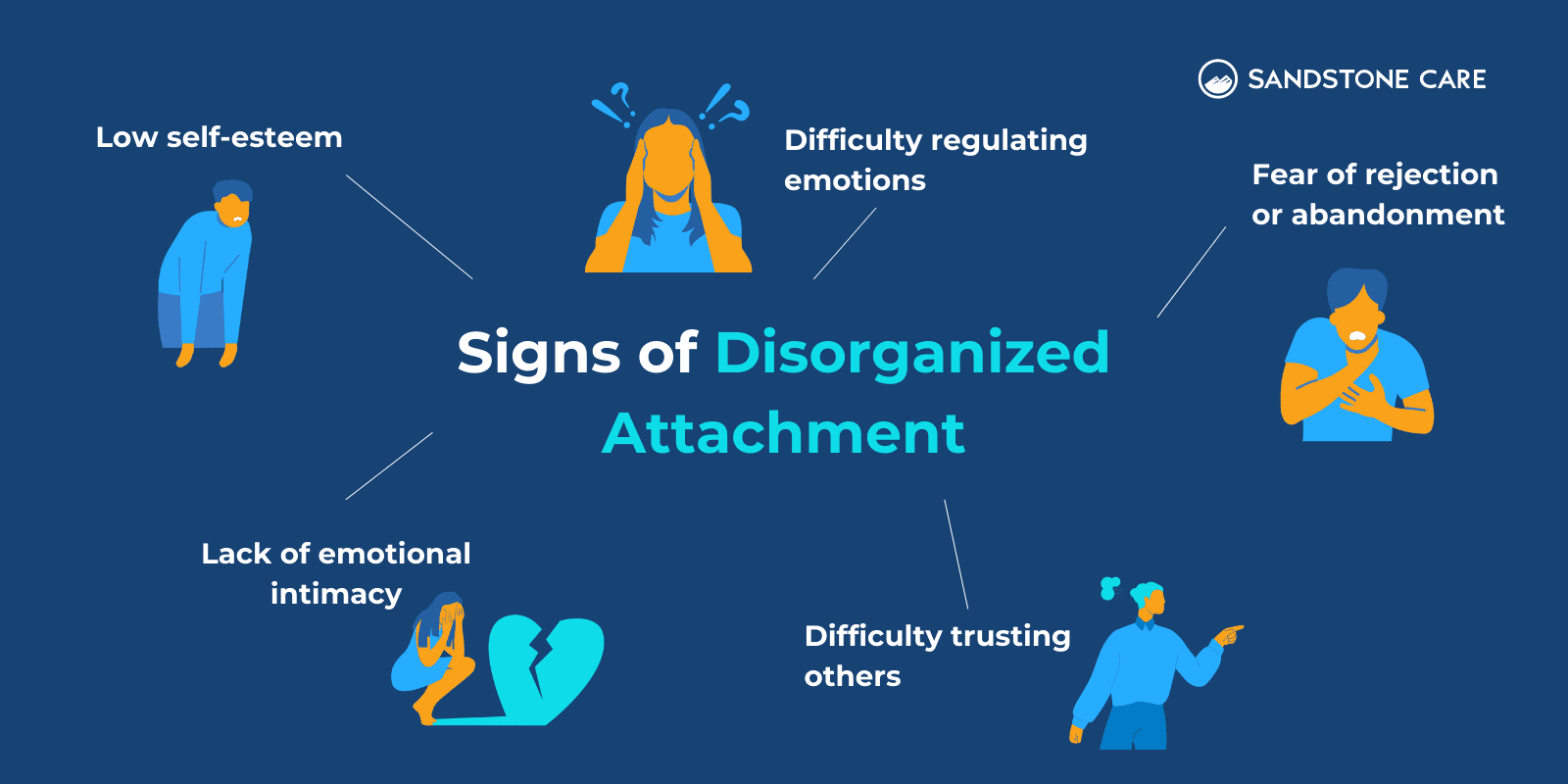
What Is an Example of Disorganized Attachment?
An example of disorganized attachment can be seen in a young child in the strange situation procedure done by psychologist Mary Ainsworth.
When their caregiver returns after being away, they may start crawling toward them. Then, they will stop and gaze towards the floor or wall with no expression, experiencing dissociation.
This may happen because the child is confused about how to act with the caregiver, and they fear them because of their behaviors.
What Causes Disorganized Attachment?
Disorganized attachment, also known as fearful-avoidant attachment, is most often caused by a parent who does not respond to their child’s needs or is inconsistent in providing them care, support, and comfort.
Secure Attachment Style
What Are Signs of Secure Attachment?
Signs of secure attachment can include:
- Emotion regulation
- Trusting others is relatively easy
- Being able to communicate feelings
- Ability to ask for help and support
- Comfortable being alone and having close relationships
- Confidence and high self-esteem
- Able to self-reflect
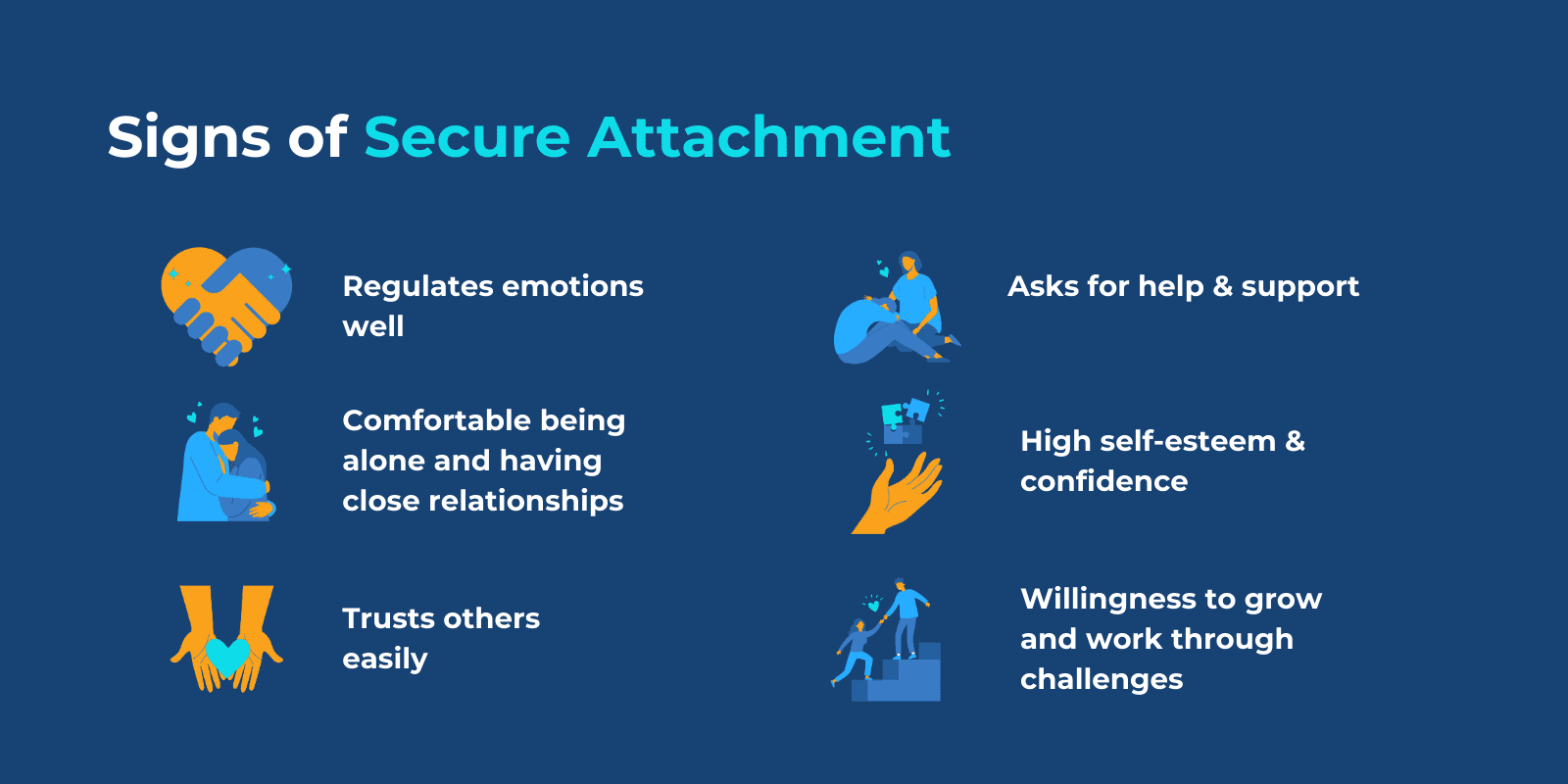
What Is an Example of Secure Attachment?
Often, people look at secure attachment in childhood.
This may be seen in a young child who feels safe enough to try something new because they know their caregiver is there to go to if they find themselves in a difficult situation.
It may also be seen when a young child is in a situation that involves fear; maybe they are meeting a stranger or scared of loud noises. In this case, the child with a secure attachment goes to their caregiver and finds comfort and relief in being with them.
For adults, secure attachment can present itself in different ways.
In a romantic relationship, someone with secure attachment feels safe and comfortable enough to share their feelings, even when they might be difficult. They also feel secure enough to reach out for help and emotional support when needed.
What Are the Four Characteristics of Secure Attachment?
Secure attachment involves four main characteristics which include:
- Safety
- Feel seen
- Security
- Soothing
When an individual has a secure attachment style, they are confident in knowing that they are safe with the person they are with. They know that they can go to them for comfort, help, and support.
They are able to express themselves without fearing judgment or anger.
These attachment behaviors give them the space to regulate their emotions, be independent, and manage stress healthily.
You have questions. We have answers.
Our goal is to provide the most helpful information. Please reach out to us if you have any additional questions. We are here to help in any way we can.
Narcissists often have insecure attachments that are either avoidant, anxious, or both (anxious-avoidant).
A narcissist may feel insecure, emotionally distant, or may have an extreme need to be close to someone so that they can have control over them.
People who have had relationships or bonded with a narcissist often have an anxious attachment style because of a lack of consistency and confusing feelings. They may have developed a fear of rejection and abandonment from the other person.
Individuals with an anxious attachment style may come off to be clingy and need to be extremely close to another person.
A person with an anxious attachment style can be clingy because they fear that the other person will abandon them. They may feel insecure about their relationships and get anxious if they are not in close contact with their partners.
On the more extreme end of anxious attachment, a person may be more likely to become emotionally manipulative because they will go through as much as they can to make sure an attachment figure doesn’t leave them.
However, it is important to note that challenges like personality disorders and toxic coping mechanisms from attachment styles are difficult for anyone to overcome. Professional treatment is often needed.
Insecure attachment styles like anxious attachment, avoidant attachment (or dismissive-avoidant), and disorganized attachment can form due to trauma and stress experienced in childhood and impact future relationships.
Trauma can lead to very difficult and confusing feelings that can lead to unhealthy relationships in both childhood and adulthood. It can be difficult to maintain long-term relationships or healthy connections because of the coping mechanisms developed during the childhood attachment process.






